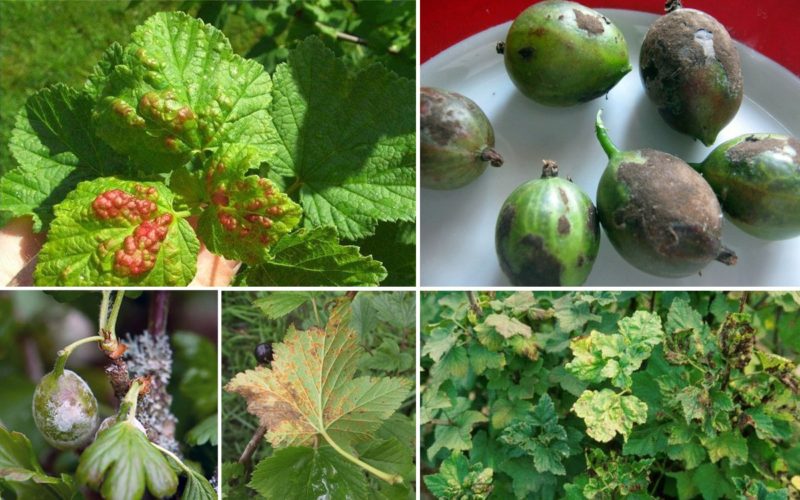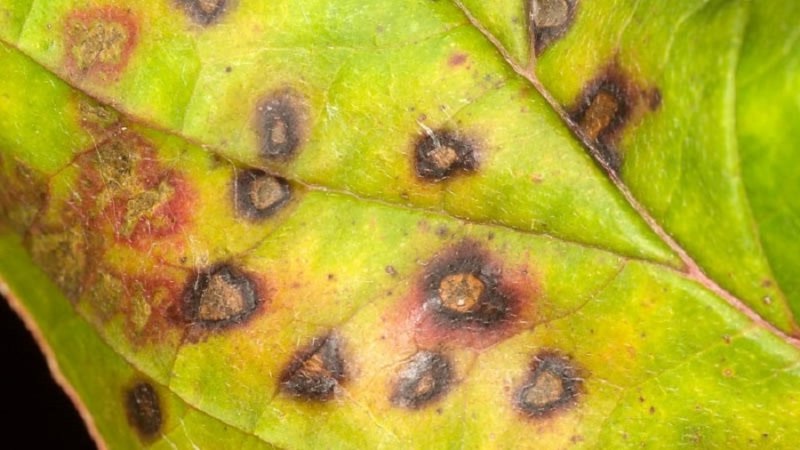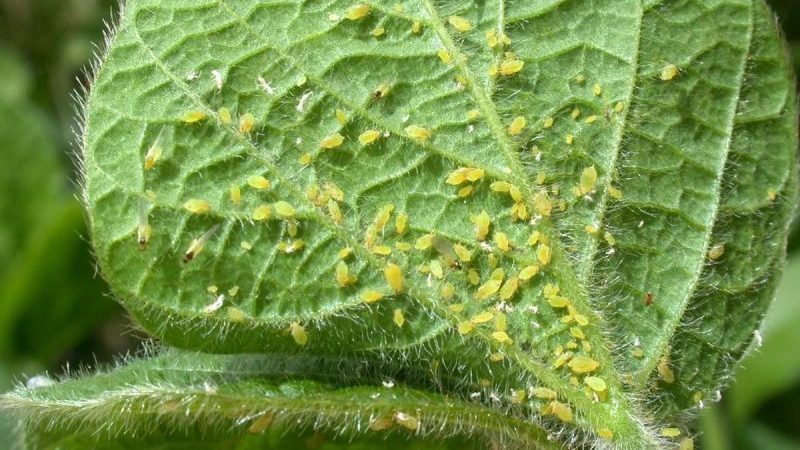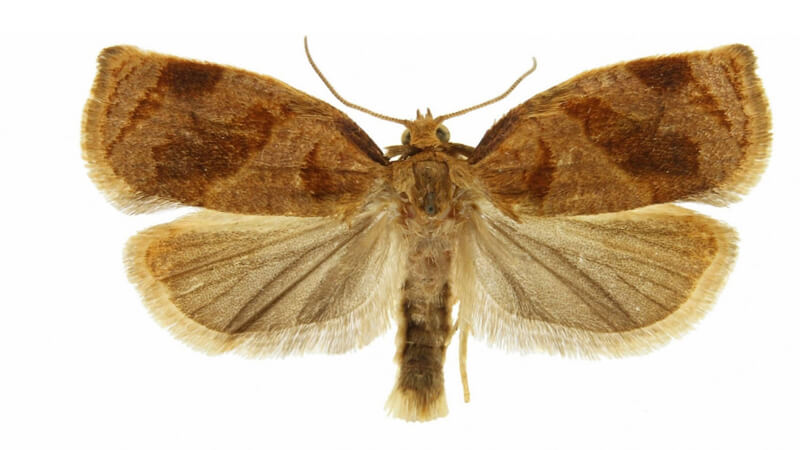Diseases and pests of gooseberries and methods of dealing with them
Diseases and pests are the main causes of crop loss and death of fruit and berry plants. Gooseberries are no exception. Pests that settle on leaves, shoots and berries, without timely measures, reduce the winter hardiness of gooseberries, lead to drying out of its branches, roots and greenery, dropping flowers and shoots.
Despite the fact that new varieties and hybrids with high immunity are constantly appearing, there are no plants with absolute resistance to all infections. To save the gooseberry, it is important to learn how to correctly identify diseases, to know methods of controlling and preventing pests and diseases.
The content of the article
Common gooseberry diseases and methods of dealing with them

Diseases of the gooseberry reduce the yield and frost resistance of the plant, and with prolonged exposure lead to its death.
Note! Gooseberry the same infections affect the currants.
There are several common causes for all diseases:
- non-compliance with the rules of care;
- weeds;
- temperature drops;
- pests;
- contaminated soil, gardening tools, planting material.
Powdery mildew
Powdery mildew is one of the most common gooseberry diseases. Its causative agent is a parasitic fungus. Sometimes it even affects varieties and hybrids that have indicated resistance to infection.
The following factors are considered the cause of the spread of the disease:
- high humidity and low temperature;
- high temperature in dry weather;
- lack of sunlight;
- poor air circulation;
- an abundance of weeds.
Powdery mildew is easy to recognize. A number of symptoms indicate a defeat:
- leaves and shoots are covered with a white bloom, which is easy to remove by wiping the affected surface;
- gradually the plaque passes to the ovary and berries, covering the entire surface of the affected parts of the plant;
- over time, the plaque becomes denser, then turns brown, turning into dark spots, resembling felt to the touch;
- damaged shoots stop growth, bend and wither;
- leaves dry up and curl;
- the fruits crack and crumble.
Diseased plants lose their crops. Their photosynthesis process deteriorates, which is why they stop developing. The infection also negatively affects winter hardiness, depriving the gooseberry of the ability to endure severe frosts. Without timely treatment, the bush dies in 2-3 years.
To get rid of the disease, all affected parts are removed from the plant, taken from the site and burned.
The gooseberries are then sprayed with antifungal agents. The most effective are fungicides, for example, Topaz. The disadvantages of such drugs are toxicity and the inability to eat the fruits after processing. They are resorted to if the disease is neglected and more gentle methods do not help.
How to deal with powdery mildew safely:
- A solution of copper sulfate. Prepared from 1 tbsp. l. vitriol and 10 liters of water.
- Soda ash and soap. Add 50 g of soda ash and 0.5 piece of laundry soap to a bucket of water. After dissolving the ingredients, the bush is sprayed with the agent.
- Mullein. 1 kg of mullein is bred in 2 liters of water. The mixture is insisted for 3 days. Then it is diluted with 9 liters of water and used to spray diseased shrubs.
- Iodine with serum. 2 liters of whey and 30 drops of iodine are poured into a bucket of 10 liters. The remaining volume is filled with water.
The means are not only sprayed on infected shrubs, but also treated plants in the neighborhood. It is also recommended to water the soil around the gooseberry.
In order to prevent the development of the disease, they annually carry out sanitary pruning, mulch the soil around the bush, follow the rules of watering, do not thicken planting gooseberries. As a preventive treatment, as soon as the snow melts, the bushes are scalded with boiling water, watering the plant itself and the soil around it. Then they are sprayed with a solution of copper sulfate.
Rust
Goblet rust - another fungal disease of the gooseberry. If untreated, it returns from year to year and leads to the fall of leaves and berries.
Rust has characteristic symptoms:
- gooseberry leaves are covered with rusty spots, on which light orange bolls with spores are formed;
- the shape of the leaf plates changes, becomes ugly;
- greens fall from the bush ahead of schedule;
- berries become small, take on an irregular shape, dry out and fall off.
The fungus lives on the affected leaves all summer. Winters on fallen greenery. The wind spreads to other crops and weeds.
To fight rust, fungicides or folk remedies are used. Often, to get rid of the problem, 3 times of treatment with 1% Bordeaux liquid is enough.
In order to prevent infection of plants, fallen leaves are collected and burned in the fall. Weeds are removed around the bushes, the soil is mulched.
Council. The best prevention of rust is the choice of varieties that are resistant to it: African, Isabella, Krasnoslavyansky, Yantarny, Chernomor.
Anthracnose
Anthracnose causes a fungal infection. It attacks the leaves, causing them to fall off. Because of this, photosynthesis worsens, the growth of shoots stops, the taste of berries deteriorates and their number decreases.
To avoid undesirable consequences, it is important to timely identify the disease. It has the following features:
- leaf plates are covered with small dark brown spots of irregular shape;
- gradually the spots grow and merge;
- leaves dry and fall off.

In the early stages of the development of the disease, gardeners prefer to do without serious chemicals using the following methods:
- A solution of copper sulfate. 40 g of copper sulfate are dissolved in 10 liters of water. This remedy is used at the initial stage of the development of the disease.
- Bordeaux liquid. Bushes are treated with a 1% solution before flowering, immediately after it, 2 weeks after flowering and after harvesting. Reusable treatments save plants and prevent contamination the next year.
- Ashes. Take 1 kg of ash per bucket of water. The mixture is infused for 3 days, after which 1 piece of grated laundry soap is added. The composition is sprayed with gooseberries every week until the problem is solved.
Before treatment with any preparations, the affected leaves are cut off and burned. Medicines are sprayed not only on the plants themselves, but also on the soil around them.
To exclude gooseberry contamination, in the spring the bushes are scalded and treated with copper sulfate. Be sure to follow the rules for watering, carry out sanitary pruning and remove weeds.
It is interesting:
How to process tomatoes with Bordeaux mixture - step by step instructions for beginners.
How to feed tomatoes with boric acid, iodine and ash.
How to properly apply copper sulfate from late blight on tomatoes.
Septoriasis
Septoria is also called white spot. The causative agent of the disease is a fungus. The disease leads to premature leaf fall and impairment of photosynthesis.
Septoria is recognized by the following features:
- leaf plates are covered with a large number of small round light gray spots with a dark border;
- later, black dots appear on the spots, which represent spores of the fungus;
- leaves curl and dry out.
To get rid of the disease, they pick off the affected greens from the bush and collect the leaves that have fallen off.Plants are sprayed with a solution of copper sulfate or Bordeaux liquid.
To reduce the risk of infection, all fallen leaves are removed and burned in the fall. The soil is loosened after each watering. Be sure to use fertilizers containing manganese, boron, zinc, copper.

Mosaic
Gooseberry mosaic is a viral disease. It spreads through infected garden tools, other plants, pests.
Bright yellow spots appear along the veins on the leaf plates of the infected plant. The leaves become small and wrinkled. Bushes stop growing and yield a scanty harvest.
It is impossible to cure diseased plants. They are dug up and burned.
In order to prevent infection, planting material and garden tools must be disinfected. It is advisable to choose varieties that are resistant to viral infections.
Scab
Scab is a disease caused by fungi and bacteria. The fruit becomes inedible and falls off. Leaves fall off, shoot development slows down.
The following symptoms indicate defeat:
- brown spots appear on the leaves and shoots;
- fruits are covered with green and brown growths;
- berries are deformed and flaky;
- leaves fall.
For prevention and treatment, plants are treated with "Fitosporin".
Mold
Gray mold is also called mold. First, the disease affects the shoots - they are covered with a gray bloom. Berries acquire the same shade. They begin to rot and then crumble.
To get rid of the disease, gooseberries are treated with Fundazol. The product is used before flowering and after harvest.
Gooseberry pests: description and methods of control
There are many insects that infect the leaves, fruits and shoots of the shrub. Beetles, larvae and caterpillars on gooseberries are dangerous not only because they feed on different parts of the plant, but also spread the infection:
- Aphid - small green insects - feeds on the sap of the green parts of the plant, causing them to wilt and stop the development of shoots. Plants infected with aphids have twisted leaves, inside of which pest colonies live. Female aphid spawners look like midges with wings. They are transferred to other plants and multiply there.

- Leaf chewer. If black bugs with a green tint and yellow paws appear on the gooseberry, you need to urgently take action. They feed on leaves, gnawing large holes in them. With an invasion of pests, the foliage on the bush dries up.
- Sawfly pale-footed gooseberry. A black insect with white legs lays green naked larvae in burgundy cocoons, where they hibernate. In the spring they pupate and lay eggs in the leaves. From them larvae hatch, resembling caterpillars, which gnaw through the leaves from the inside. Due to the pest, the leaves fall off prematurely, the shoots stop developing, the winter hardiness of the gooseberry decreases.
- Yellow gooseberry sawfly. A yellow insect with transparent wings and a yellow head lays the larvae along the veins on the back of the leaf plate. The larvae, green with black spots, resemble caterpillars with legs. The pest eats the leaves, leaving only cuttings. It feeds on a sawfly and berries. In autumn, the pest goes into the soil, and in spring it hatches.
- Leaf roll. This is a butterfly whose caterpillar harms the gooseberry. The caterpillar is brown or green with a black head and chest plate. The pest hibernates in white cocoons under the bark and near the buds. Caterpillars feed on leaves, buds, buds, and fruit skins. Parts of the plant affected by the leafworm pull together white threads, resembling a cobweb. Such pests cause deformation of berries and leaves and a complete loss of yield.

- Fire. A moth that lays larvae on gooseberries. First, the caterpillars are white-yellow with a black head, then they turn green with black stripes. It is this pest on the gooseberry that is called the moth.Caterpillars eat the flesh and seeds of berries, enveloping them with cobwebs and leading to rotting.
To reduce the likelihood of plant pests, it is important to follow the rules of prevention. Plant residues are collected and burned after leaf fall. The soil around the gooseberry is watered with boiling water and a solution of copper sulfate.
If the invasion of pests has been recorded repeatedly, in the spring, before the gooseberry bloom, the bushes are treated with chemicals. The most effective for the fight against pests and diseases are considered "Fufanon", "Iskra", "Kemifos", etc.
How to get rid of pests if there are already berries
If pests attacked the plants in June or July, when the berries have already set, chemical preparations cannot be used. Otherwise, the crop will be unfit for human consumption. During fruiting, safer methods are used to eliminate harmful insects:
- Manual collection. Large pests are collected from the bush by hand.
- Washing off with water. The bush is watered from a hose under pressure, washing off the pests. The rest of the insects are collected by hand.
- Insects. For example, a ladybug successfully copes with aphids. There are special mites to combat other pests.
- Decoction of bitter herbs. They are sprayed with shrubs infected with pests. Decoctions of dandelion, wormwood, yarrow, celandine are suitable.
- Soap and orange peels. The peel of 10 oranges is poured into 2 liters of water and insisted for 14 days. The product is filtered, poured into a 10 liter bucket, a piece of laundry soap is rubbed there, the rest of the volume is filled with water. The product is used for spraying.
Conclusion
Diseases and pests pose the biggest threat to gooseberries. They are considered the most common cause of the death of shrubs and loss of crops. Gooseberry infections can spread to other fruit and berry plants.
To avoid unpleasant consequences, it is important to recognize the infection or pest in a timely manner and choose the right control method. Many gardeners prefer folk remedies, as well as chemicals that are harmless to humans and the environment.